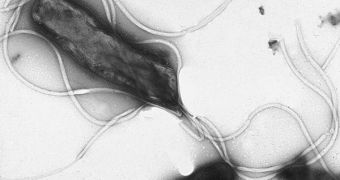Waste-treatment tanks across the world offer bacteria the most appropriate spawning ground, as well as the ideal conditions for the appearance of antibiotics-resistant “superbugs”, similar to the MRSA (Methicillin-resistant Staphylococcus aureus). These centers of infection are made incredibly dangerous by the fact that an accident can discharge them into streams or lakes at any time, and thus allow them to contaminate fish populations, with potentially devastating consequences for humans as well.
University of Michigan School of Public Health (UM-SPH) Assistant Professor Chuanwu Xi led a team of scientists into the field, to analyze waters from several sites around the Ann Arbor wastewater-treatment plant. At five of these locations, the researchers identified the Acinetobacter bacterium, of which several species linger in hospital environments and cause severe, life-threatening infections in patients with already compromised immune systems. For healthy individuals, most of these bacteria are considered harmless, although exceptions in which people were affected have been noted over the years.
The investigation also revealed that traces of bacteria strains resistant to at least one antibiotic had been found up to 100 meters downstream from the waste-treatment plant's discharge into the nearby Huron River. Xi was careful to mention that, while the discovery might, indeed, be very frightening, more studies were required if public health experts were to deem the threat levels posed by these organisms to the general human population. “We still need to understand the link between aquatic and human multiple drug-resistant bacteria. Twenty or 30 years ago, antibiotics would have killed most of these strains, no problem,” he said.
After analyzing water samples before and after the treatment process, the investigators concluded that the number of bacteria coming out of the discharge following the purification were significantly lower than the number found in the actual tanks, which meant that the process was fairly effective in keeping pathogens away from people. On the other hand, bacteria that did manage to survive the treatment, and came out through the discharge, were those that could withstand the joint action of many types of antibiotics.
One of the main reasons why treatment plants are so “good” to bacteria is that the treatment tanks offer the microorganisms the perfect setup to start consuming organic matter, which can feed both good and bad bacteria. As the “bad” ones grow, they exchange genetic material, which means that the ability to resist drugs gets a bunch of mutations. At some point, a superbug emerges, that is resistant to almost anything doctors throw at it.

 14 DAY TRIAL //
14 DAY TRIAL //